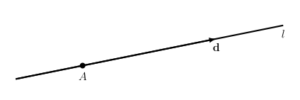1. Find the equation of line $l_1$ which contains points $A$ and $C$.
$\overrightarrow{AC} = \overrightarrow{OC} - \overrightarrow{OA} = \begin{pmatrix} 2 \\ 4 \\ -6 \end{pmatrix} = 2 \begin{pmatrix} 1 \\ 2 \\ -3 \end{pmatrix}$.
$(\mathbf{i}+2\mathbf{j}-3\mathbf{k})$ is a direction vector of the line and it passes through the point $A(3,-1,6)$.
Hence equation of line is
Since the line passes through $B(1,-1,-4)$ and is parallel to $l_1$ (it hence shares the same direction vector), equation of line required is
$\mathbf{r} = \begin{pmatrix} 1 \\ -1 \\ -4 \end{pmatrix} + \mu \begin{pmatrix} 1 \\ 2 \\ -3 \end{pmatrix}, \mu \in \mathbb{R}$.
Converting to cartesian form, we get $\displaystyle x-1=\frac{y+1}{2}=\frac{z+4}{-3}$.
Vector equation of a line
To form an equation of a line, we need two things:
- A point on the line. We will denote the point as $A$ and its position vector $\mathbf{a}$
- A vector that is parallel to the line. We will will call this vector the direction vector and denote it by $\mathbf{d}$.
In vector form, we will write the equation of a line $l$ as
For example, if a line $l$ passes through $A(1,2,3)$ and is parallel to $(-\mathbf{i}+\mathbf{j}-3\mathbf{k})$, we will write the equation of the line as
$$ l: \mathbf{r} = \begin{pmatrix} 1 \\ 2 \\ 3 \end{pmatrix} + \lambda \begin{pmatrix} -1 \\ 1 \\ -3 \end{pmatrix}, \lambda \in \mathbb{R}$$
Different values of $\lambda$ will give rise to the position vectors of differnt points on the line. For example, using $\lambda=0$ and $\lambda=1$ allows
us to determine that $(1,2,3)$ and $(0,3,0)$ lies on $l$.
Many questions involving lines will involve solving for $\lambda$ to determine special points on the line.
Let $R$ be a general point on the line $l$ with position vector $\mathbf{r}$. It is given that $l$ has direction vector $\mathbf{d}$ and passes through point $A$ with position vector $\mathbf{a}$.
Observe that $\overrightarrow{AR}$ is parallel to the line and thus $\mathbf{d}$. Hence $\overrightarrow{AR} = \lambda \mathbf{d}$ where $\lambda \in \mathbb{R}$.
$\mathbf{r}-\mathbf{a} = \lambda \mathbf{d} \\
\mathbf{r} = \mathbf{a} + \lambda \mathbf{d}, \lambda \in \mathbb{R}$.
Parametric and cartesian equations of a line
Consider the line with vector equation $$l: \mathbf{r} = \begin{pmatrix} a_1 \\ a_2 \\ a_3 \end{pmatrix} + \lambda \begin{pmatrix} d_1 \\ d_2 \\ d_3 \end{pmatrix}, \lambda \in \mathbb{R}$$
If we let $\mathbf{r} = \begin{pmatrix} x \\ y \\ z \end{pmatrix}$, we get three equations
$$\begin{align}
x &= a_1 + \lambda d_1 \tag{1} \\
y &= a_2 + \lambda d_2 \tag{2} \\
z &= a_3 + \lambda d_3 \tag{3}
\end{align}$$
These three equations constitute the parametric equation of a line.
If $d_1, d_2, d_3 \neq 0$, then making $\lambda$ the subject for each equation gives us
$$\lambda = \frac{x-a_1}{d_1} = \frac{y-a_2}{d_2} =\frac{z-a_3}{d_3}$$
This gives us the cartesian equation of a line:
If $d_1 = 0$ and $d_2, d_3 \neq 0$, then our cartesian equation becomes
$$ x = a_1, \frac{y-a_2}{d_2} = \frac{z-a_3}{d_3}$$
since the parameter $\lambda$ 'disappears' for the equation involving $x$. The cases where $d_2$ and/or $d_3$ is $0$ are handled analogously.
Try the extra problem (questions 1 and 2) at the end of this page to see this idea in action.
Extra practice
- Convert the line with equation $\mathrm{r} = \begin{pmatrix} 2 \\ 0 \\ -3 \end{pmatrix} + \lambda \begin{pmatrix} 1 \\ -2 \\ 0 \end{pmatrix}, \lambda \in \mathbb{R}$ to cartesian form
- Convert the line with equation $ \displaystyle \frac{x}{2} = 1 - z, y = -2$ to vector form.
- Determine if $B(3,0,3)$ and $C(3,1,0)$ lie on the line
$$ l: \mathbf{r} = \begin{pmatrix} 1 \\ 2 \\ 3 \end{pmatrix} + \lambda \begin{pmatrix} -1 \\ 1 \\ -3 \end{pmatrix}, \lambda \in \mathbb{R}$$ - (Requires knowledge of planes) Find a vector equation of the line that is perpendicular to the plane $x+y-2z=0$ and contains the point $(1,3,-5)$.
- $\displaystyle x-2=\frac{y}{-2}, z=-3$.
- $\mathbf{r} = \begin{pmatrix} 0 \\ -2 \\ 1 \end{pmatrix} + \lambda \begin{pmatrix} 1 \\ 0 \\ -1 \end{pmatrix}$.
- Substituting $\overrightarrow{OB}$ into the equation,
$ \begin{pmatrix} 3 \\ 0 \\ 9 \end{pmatrix} = \begin{pmatrix} 1-\lambda \\ 2+\lambda \\ 3-3\lambda \end{pmatrix}$ Hence we have
$\begin{align} 1- \lambda &= 3 \tag{1} \\ 2+ \lambda &= 0 \tag{2} \\ 3 - 3\lambda &= 9 \tag{3} \end{align}$.
Solving each of the three equations gives us the solution $\lambda=-2$. Since the system of equations is consistent, $B$ lies on the line.
Repeating the process for $C$, we have
$\begin{align} 1- \lambda &= 3 \tag{4} \\ 2+ \lambda &= 1 \tag{5} \\ 3 - 3\lambda &= 0 \tag{6} \end{align}$.
Equation (4) gives us $\lambda=-2$ while equation (5) gives us $\lambda = -1$ and equation (6) gives us $\lambda = 1$. Hence the system of equations is not consistent and $C$ does not lie on the line. - Since the line is perpendicular to the plane, the line is parallel to the normal vector of the plane, $\mathbf{i}+\mathbf{j}-2\mathbf{k}$.
Hence the equation of the line is
$\mathbf{r} = \begin{pmatrix} 1 \\ 3 \\ -5 \end{pmatrix} + \mu \begin{pmatrix} 1 \\ 1 \\ -2 \end{pmatrix}, \mu \in \mathbb{R}$
